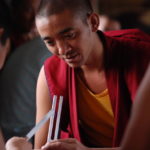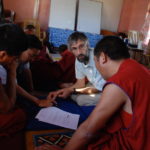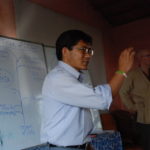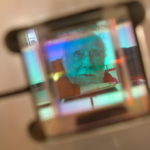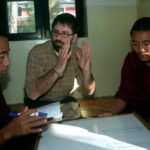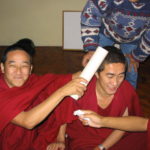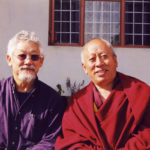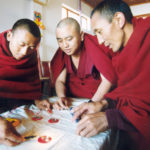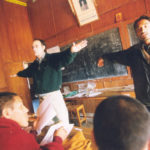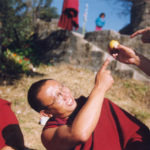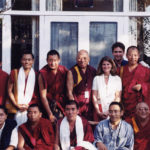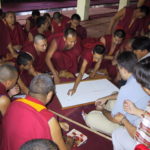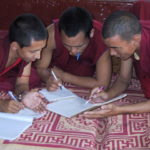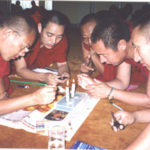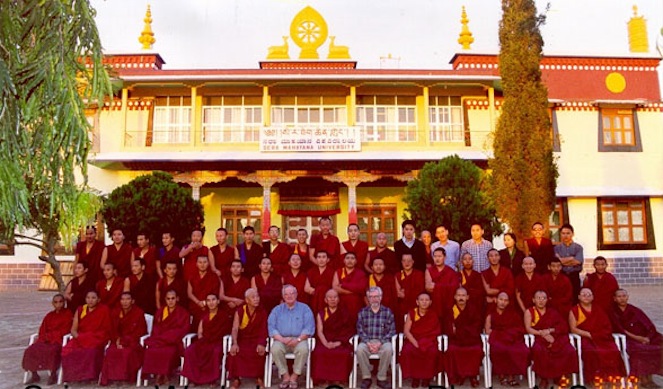
Our story begins in 1999 when His Holiness the Dalai Lama instructed Achok Rinpoche, the former director of the Library of Tibetan Works & Archives (Tibetan Library) to launch an initiative to introduce science to the “three major seats,” to scholarly monks at the three great monasteries of Gaden, Drepung, and Sera. In the first year of the project, the Tibetan Library set up a team of three translators to translate the first educational scientific writings into Tibetan, and at the same time planned a 4-week science course for a select group of scholarly monks.
The Library of Tibetan Works & Archives (Tibetan Library) monastic science initiative began in 1999 through the instruction of His Holiness the Dalai Lama View to former director, Achok Rinpoche. Although the Tibetan Library had almost no expertise in science at the time, their capacity as a center of learning serving all the major Tibetan Buddhist traditions was well suited for launching the initiative.
In the first year of the project, the Tibetan Library set-up a team of 3 translators to translate various educational scientific writing into Tibetan and at the same time planed a 4-week science course for a select group of scholarly monks. In 2000, a group of 50 monk scholars with a deep understanding of Buddhist philosophy were selected to participate in the first 4-week science workshop.
Science Workshops (2000 – 2007)
In 2001, the Sager Family Foundation created a partnership with the Tibetan Library to grow and sustain the Library’s historic undertaking. The Science Workshops (2000-2007) were an historic program and represent the first formal teachings of science within the history of Tibetan Buddhism. Overcoming a multitude of challenges of finding qualified teachers, translators and the daunting but vital task of coordinating participants from several monasteries and teachers from around the world, nine 4-week intensive science workshops were successfully implemented between 2000 and 2007.
In 2006, Geshe Lhakdor became the director of the Tibetan Library, and initiated efforts to grow the science programs and establish a dedicated “Science Department” at the Tibetan Library in Dharamsala.
Sager Science Leadership (2008 – present)
In 2008, we launched a new initiative to focus on supporting monks and nuns that can contribute to indigenous science learning and community engagement activities that connect Buddhism and science. The Sager Science Leadership Institute graduated its first cohort in 2010, a second cohort in 2013, and a third cohort in 2019.
During these three cohorts we developed relationships with faculty and a few institutions that have become critical friends and partners in our work, including the Exploratorium’s Teacher Institute, the National Writing Project, and the Smithsonian Institution.
Monastic Graduates Course & Dialogue (2011 – 2018)
Responding to a request from the Dalai Lama, we launched a program to reach senior monks and nuns that had graduated from their formal monastic studies and were now educational leaders, administrators and community mentors. Central to the monasteries’ ability to adapt and nurture new generations of monks learning science was reaching the senior monks that guided and oversaw traditional studies. A 4-week introductory science course, representing the best topics and activities and faculty, was developed. This course evolved and expanded as it was taught seven times.
This program is offered to senior monastics who have completed their formal monastic learning and are well-prepared to be trained as educational leaders in their respective monastic communities.
We had 32 participants for the program of 2023 Monastic Graduate Course, with 24 of them being monks and 8 nuns from various monasteries and nunneries. The program started on October 8 and ended on October 28, 2023. During the three-week intensive training, the participants were introduced to basic science learning, which included a lot of hands-on activities to refine their learning. And a designated time is given priority for writing exercises to reflect on and summarize what they had learned in the class.
Bhutan Science Leadership (2016 – present)
For three years, from 2016 to 2018, we organized an annual 10-day exploratory science workshop in Bhutan. These workshops gave a hands-on introduction to science for monastics from across the country and positioned us to launch a new leadership initiative in 2019.
The Bhutan Science Leadership Programme was conducted from 15th to 25th December 2022 and had twenty participants representing some of the monasteries in Bhutan. The workshop on Physics and Astronomy was interactive, with a focus on holistic learning.
The 2023 leadership program in Bhutan was hosted by Rinpung Dzong, Paro. It started on December 2nd and concluded on December 9th 2023. Julie from Exploratorium conducted the class for a week, and Lama Ngodup from Bhutan helped in interpreting it into English. We had 41 participants from different age groups, and they were all learning science for the first time.
Science Leadership for Nuns (2017 – present)
In 2017, our monastic graduates course was tailored to reach a group of nuns that were highly advanced in their Buddhist studies. This course led to the launch of a new initiative dedicated to nuns. We organized our first science workshop for nuns at Kopan Nunnery in 2018. In 2019, we launched a first all-nuns leadership cohort, for 33 nuns from 5 different nunneries who volunteered to take part in a three-year program that provided assistance and training for the creation of science leaders. Hence, these leaders will take on new educational and community development initiatives and reinforce and improve monastic science teaching. Neuroscience workshop was conducted from 12th March to 30th March 2023 for the nuns. 23 nuns from different nunneries convened at LTWA, Dharamsala for the exclusive neuroscience classes.
The second cohort nuns’ leadership program commenced on March 11th at LTWA, Dharamsala for three weeks and it lasted till March 31st, 2024. For this leadership program, we had 40 nuns from 4 different nunneries, most of whom are learning science for the first time. The three-week rigorous science learning program was designed as, for the first-week teachers from the science department of LTWA had conducted the classes whereas, they brushed up on the basics to prepare them for the second and third week. Guest teachers took over the class for the second and third weeks.

